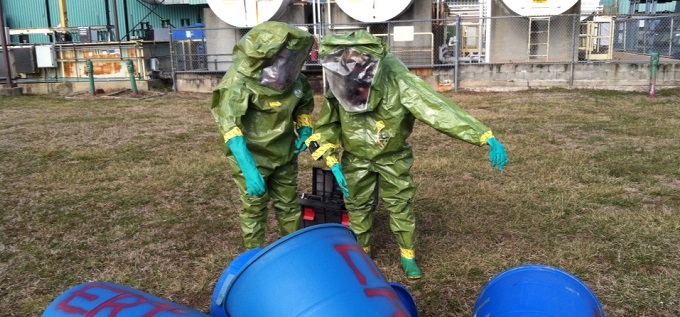Combining public and environmental safety training
By Dennis Pierce
November 29, 2016
Public safety training at Greenville Technical College now includes environmental health and safety training.
As the rescue efforts at the World Trade Center after Sept. 11 demonstrated, emergency responders are often exposed to hazardous materials—and there is a significant overlap between public and environmental health and safety.
“Providing a workforce that is trained in disaster site response, and making sure responders to these events are trained in proper health and safety and are protecting themselves and the environment, is a huge area that needs to be addressed,” says Kirk Laflin, executive director of the National Partnership for Environmental Technology Education (PETE) and the National Environmental Safety and Health Training Association.
Greenville Technical College (GTC) in South Carolina has recognized this emerging need by combining its environmental and public safety programs into one department.
“We are unique in the breadth of our programs,” department head Joy Finch says. “We offer everything from traditional health and safety training, like CPR or waste water management, to OSHA training and the handling of hazardous materials.”
As health and safety requirements change, GTC responds quickly by creating new programs to meet these demands. “When OSHA changed its confined space regulations, we developed a class to certify a confined-space competent person,” Finch says. “And when our state regulator recently started requiring certified food protection managers in restaurants, we developed a class for that, too.”
Public safety professionals must learn to recognize hazards such as asbestos, mold, chemicals, and other materials that can become exposed during a natural or manmade disaster. But the volunteers who want to lend a hand in disaster recovery should have this training as well, Laflin observes.
Community colleges don’t have to “reinvent the wheel” to offer this type of training, he says. PETE’s Community and College Consortium for Health and Safety Training (CCCHST) offers curriculum and professional development to help colleges train their faculty in disaster preparedness education. “In many cases, our programs are funded by federal programs,” Laflin says. “At least 80 to 85 percent of the cost is covered for those faculty members to become trained.”
GTC has offered a citizen preparedness course to help volunteers learn about local emergency plans, common hazards, evacuation procedures and how to help people with disabilities.
“Our instructors were local EMS professionals who attended a train-the-trainer course sponsored by PETE/CCCHST,” Finch says. “We also have the capability to offer OSHA Disaster Site Worker training. Demand for this course has not been very high in our area, but we are hoping it will grow as we provide information to the restoration contractor community about its availability.”
Environmental health and safety programs are critical, she says, because they affect all sectors of the economy. “You’re not going to have much economic development unless you can meet the environmental and safety needs of your workforce and community,” she notes. “There is a huge cross-sector need for this kind of training.”
This article is part of a larger story on public safety training featured in the upcoming December/January issue of Community College Journal.
Continue the conversation on LinkedIn.



